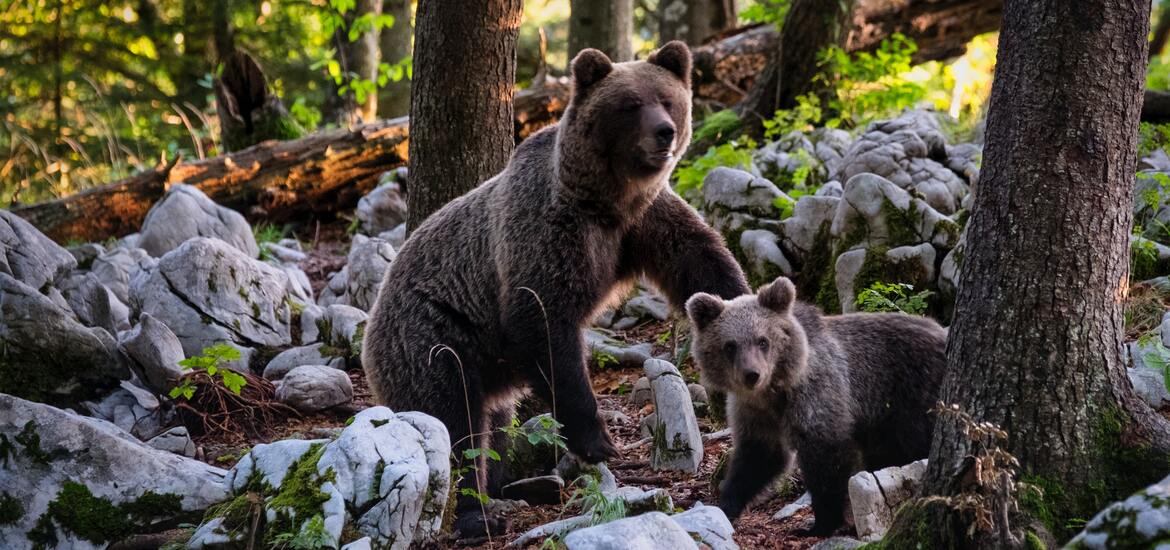I’m alone in the woods. It is 6:15 in the morning and I am just about to complete my regular jogging circuit. I puff my way up a steep and narrow incline, birch branches whipping my arms, wild rose runners scratching my shins. I breathe deep and my lungs rejoice for air so clean, so crisp, I could cry with gratitude. Suddenly, I spot rapid movement in a nearby tree. A bear cub is clawing its way into the canopy of an Alder. In an instant, I scan for Mama, for where you spot a cub she will not be far behind, and this time is no different. A stone’s throw away, standing at full height on it’s haunches, shoulders up, and fur fanned out, is a massive mother bear. She is looking straight at me.
Oh God.
I have no time to think. I turn mechanically, abandon course, and bushwack vertically up the hillside toward a stranger’s property some 120 feet away. I do not breathe. I do not think. I just keep moving. Calm but listening. Yes, listening for the sound of heavy steps, snapping branches, or laboured breathing coming up behind me. After me. I do not look back. I barely drag in breath until I make it onto the stranger’s property determined to face human wrath for trespassing than a mama bear’s fury at a threat to her young.
This encounter occurred no more than a week ago. As I type these words for you I feel every inch of this experience prickle across my skin. It reverberates through my mind, and will live within my body for weeks to come. Within my memory for years.
I live surrounded by wilderness. I have chosen to live my life tucked away from concrete jungles, sirens and street lights. I have rejected the wilds of urban life in favor of quiet and rhythmic living, connected to the land and open to it’s wisdom and yes, it’s bears.
Now I ask you a startling, and likely, wildly inappropriate question. As you envisioned all that I described above, what do you imagine that I, the writer, look like? Yes, I know, the question is rather elementary, but I ask it anyway. What are your knee jerk assumptions about who and what I am? You may, of course, keep your answers to yourself, but nevertheless, answer honestly.
Now, would it cause you to raise your brow to learn that I am a deeply black skinned woman? That I have dreadlocks that run down my back and a penchant for oversized earrings? Would it surprise you to learn that I am a performance artist and folklorist steeped in afro-centric experience and history? That I devote much of my life to the phenomenon of human existence in black skin. With this knowledge in mind, does any part of you then feel the slightest need to ask what in the world I am doing in the woods?
Though our politically correct society may quash you for ever asking such a question publically, I believe you would come by it honestly (due, in part, I’d like to think, to a modicum of concern for my bodily well being). Black skin in the wilderness is an anomaly in my neck of the woods (pardon the pun). Black skin surviving, let alone thriving, outside of urban settings is often nothing less than newsworthy. It goes so much against the grain of what is expected of North American blacks. It is a deviation from the narrow bandwidth we’ve been given to occupy.
As one on the inside of this deviation, and as an artist, I cannot help but reflect on this facet of my reality. When the media exploded over the murder of George Floyd and black life was given center stage in 2020, the small village of 800 predominately white people where I live responded in good faith. A Black Lives Matters rally was organized and nearly 300 people turned out to march silently through our single downtown street in vigil. As one of the only visibly black members of this community the weight of being a lone representative of the Black Struggle was more than my little heart could bear. I hid myself away on the day of the march, overladen with sorrow, and cried amidst the poems of Langston Hughes.
Indeed, the social uprising of 2020 brought many emotions to the surface for people of all walks of life. I was made to sense acutely the utter loneliness of my blackness outside of the urban throng. I am left alone to understand it, my blackness that is, and what it means for me and those around me. I am left alone to value the anomaly that I am and the fullness of my heritage while wading through the micro-social-abrasions that nick not only my skin but my heart as well. In brief, for me, to be black and rurally based is to brave a variety of loneliness that will either numb or fiercely motivate me.
I have chosen the latter. In September of 2020 I was successfully granted provincial funding to embark on a research project to bring to light this particular ‘deviation’. Simply called The Black and Rural Project, I have made it my aim to interview black people who live in rural settings from across the country. I work to gather their reflections, insights and experiences on life in their skin, especially in relation to the setting in which they live. Why do they choose to live where they are (more often than not) an extreme minority? What is their relationship to mainstream black culture and their ancestral heritage? How are these relationships affected (if at all) by their rural setting? What does it mean to them to be “black and rural”?
To date I have collected dozens of interviews asking questions just like these and more. The conversations have been staggering. The themes, at times expected, and at others, blindsiding. Yet, more often than not, a deep sense of amazement and gratitude overcomes both the interviewee and I at the opportunity to even have this conversation. To speak out the intricacies of this particular experience - being black on Canada's countryside.
The project has met with great support. It has been featured on CBC, Global News Toronto, and a host of independent media outlets all interested in this unexpected perspective. Word is spreading and interviewees are coming out of the woodwork (another pun!). I am delighted, for the aim of this project is to weave audio clips and stories from the interviews into a multi-media live performance piece and digital gallery. If I have it my way, the performance will tour urban and rural theatres, schools, and heritage centers throughout the country by 2023. The digital platform will serve as a place of education for the general public and a place of connection for the scattered but strong black and rural souls of this land.
An exciting juncture on the horizon is the partnership between HeritageSask and myself to create Black and Rural in Saskatchewan. In collaboration with the Saskatchewan African Canadian Heritage Museum, I will have the privilege of reaching out to contemporary rural dwelling blacks in Saskatchewan and to explore the rich history of black presence on the land in historical settlements like Maidstone, Eldon and beyond. In fact, through my research for Black and Rural my eyes have been opened for the first time to the simple fact that blacks have been in Canada for over 400 years and much of this footprint is outside of urban settings (facts omitted from public school curriculum in my day). From the Black Loyalists in the late 1700s farming swampy lands in Upper Canada to black migrants from Oklahoma in the early 20th century settling on prairie fields in Saskatchewan and Alberta, I am forced to consider that perhaps we contemporary rural blacks are not such a deviation afterall.
I can’t help but wonder how many of these homesteading blacks encountered bears, cougars, and wolves while etching out a life of freedom on this land. Did their skin prickle and heart race just as mine did each time they came face to face with their fierce and unpredictable neighbours of the wild? Did it matter to either of them, man or beast, that one’s skin was black while the other's fur was brown, or ashen grey? The mother bear that sent me straight up a hillside and trespassing across private land did not give one lick about the colour of my skin, or whether I was from the city or at home in the wilderness. She knew only what instinct taught her: protect her cub from the human being encroaching on her territory. Suffice it to say, Mama did her job very well. I am grateful that my skin is in one piece, and to show her this, I now jog a totally different route.
Shayna Jones is a multidisciplinary spoken word artist, and folklorist. Her research and performance work is steeped in afro-centric historic and contemporary experience. Learn more about her at: www.wearestoryfolk.com


